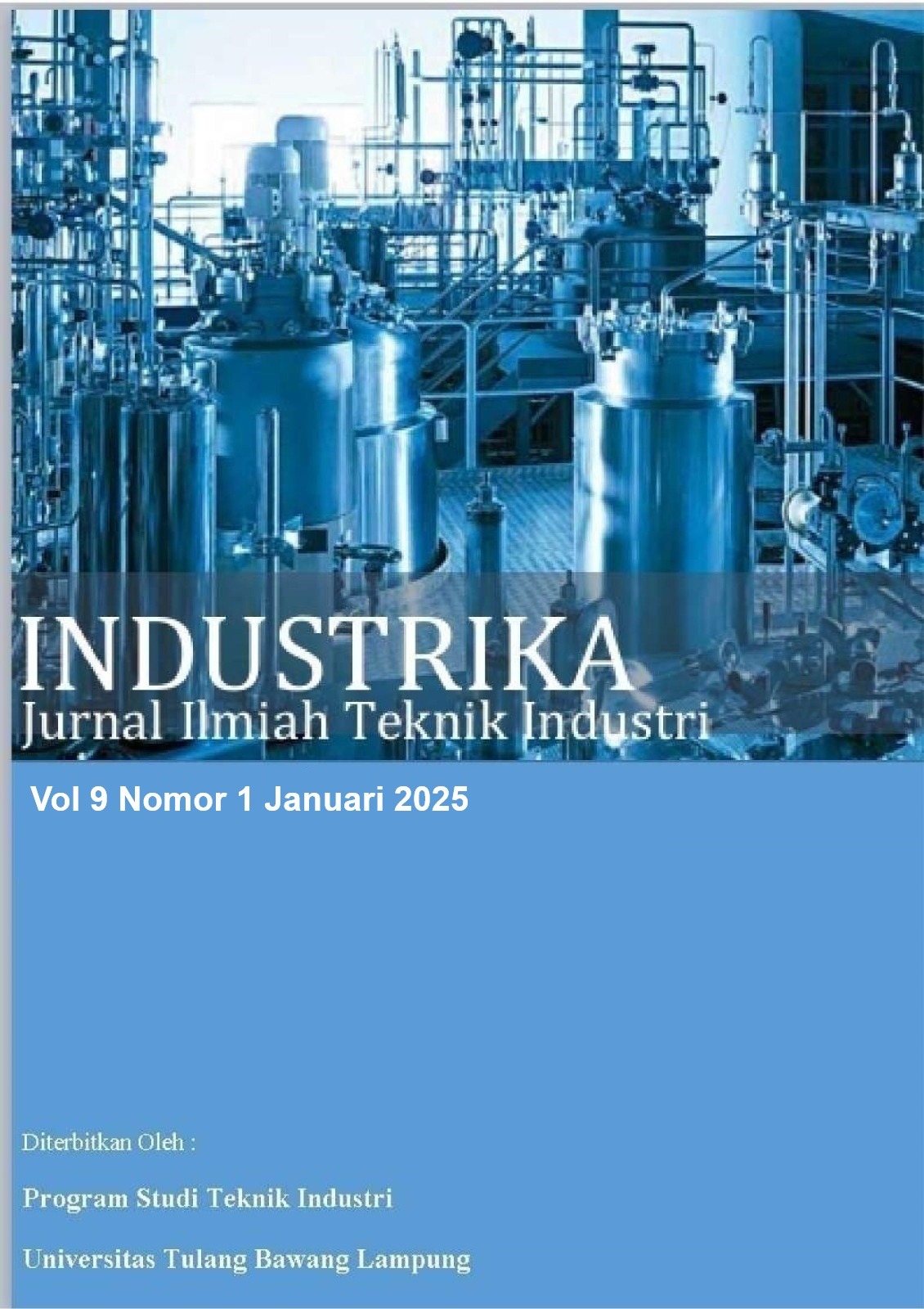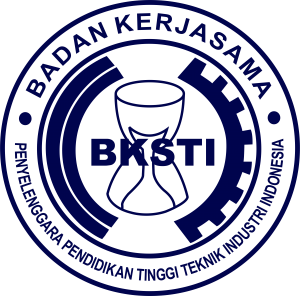Analisis Kualitas Briket Biomassa dari Limbah Sekam Padi dan Daun Kering sebagai Sumber Energi Baru Terbarukan
DOI:
https://doi.org/10.37090/indstrk.v9i1.1635Abstract
Rice husk waste and dry leaves can be found all around us. If not managed properly, it can pollute the environment. For this reason, this waste can be used to make products with economic value, for example briquettes are an alternative energy source. The trial design for making briquettes in this study used a comparison ratio (75: 25). Mixing rice husk charcoal and ground dry leaves with a ratio of 75% rice husk charcoal and 25% dry leaf charcoal, as well as adding 5% tapioca adhesive and 30% water. The briquette compression test results show that sample 1 with a maximum force of 6038.5 N has the highest compression value of 9.67 Mpa. Sample 2 with a maximum force of 713.46 N produces a compression value of 1.88 Mpa, while sample 3 with a maximum force of 1121.14 N has a compression value of 3.00 Mpa. The result is that sample 1 has the highest pressure value. The results of observing the microstructure using SEM testing showed that the size was larger, namely at 50x magnification compared to other particle size magnifications (300x, 500x 800x, and 1,000x), namely 500 µm.
Keywords: Briquettes, dry leaves, pressure test, rice husk waste, SEM test
Downloads
References
Adhani, L., Marsya, M. A., Oktavia, S., & Sindiany, I. I. (2020). Analisis bahan bakar Alternatif Komposit Biobriket dari Eceng gondok dengan Perekat Kotoran Sapi. Al-Kimiya, 6(2), 81–86. https://doi.org/10.15575/ak.v6i2.6505
Basuki, H. W., Yuniarti, Y., & Fatriani, F. (2020). Analisa Sifat Fisik Dan Kimia Briket Arang Dari Campuran Tandan Kosong Aren (Arenga Pinnata Merr) Dan Cangkang Kemiri (Aleurites trisperma). Jurnal Sylva Scienteae, 3(4), 626. https://doi.org/10.20527/jss.v3i4.2346
Eka Putri, R., & Andasuryani, A. (2017). Studi Mutu Briket Arang Dengan Bahan Baku Limbah Biomassa. Jurnal Teknologi Pertanian Andalas, 21(2), 143. https://doi.org/10.25077/jtpa.21.2.143-151.2017
Hariyanto, A. (2023). Analisis SEM (Scanning Electron Microscope) Dan Foto Mikro Pada Material Komposit Serat Tangkai Jagung Dengan Matriks Plastik Polipropilen. AutoMech : Jurnal Teknik Mesin, 3(01). https://doi.org/10.24269/jtm.v3i01.6889
Idris, S. S., Zailan, M. I., Azron, N., & Abd Rahman, N. (2021). Sustainable Green Charcoal Briquette from Food Waste via Microwave Pyrolysis Technique: Influence of Type and Concentration of Binders on Chemical and Physical Characteristics. International Journal of Renewable Energy Development, 10(3), 425–433. https://doi.org/10.14710/ijred.2021.33101
Imam Ardiansyah, Yandra Putra, A., & Sari, Y. (2022). Analisis Nilai Kalor Berbagai Jenis Briket Biomassa Secara Kalorimeter. Journal of Research and Education Chemistry, 4(2), 120. https://doi.org/10.25299/jrec.2022.vol4(2).10735
Kpalo, S. Y., Zainuddin, M. F., Manaf, L. A., & Roslan, A. M. (2020). A Review of Technical and Economic Aspects of Biomass Briquetting. Sustainability, 12(11), 4609. https://doi.org/10.3390/su12114609
Mansyur, S., & Apriani, E. (2023). Analysis of the effect of temperature and raw material mixes on the pyrolysis process with single retort-rocket stove technology on the characteristics of sawdust charcoal briquettes. International Journal of Industrial Optimization, 38–46. https://doi.org/10.12928/ijio.v4i1.6688
Murni, S. W., Setyoningrum, T. M., & Nur, M. M. A. (2021). Production of briquettes from Indonesia agricultural biomass waste by using pyrolysis process and comparing the characteristics. Eksergi, 18(1), 13. https://doi.org/10.31315/e.v0i0.4572
Niño, A., Arzola, N., & Araque, O. (2020). Experimental Study on the Mechanical Properties of Biomass Briquettes from a Mixture of Rice Husk and Pine Sawdust. Energies, 13(5), 1060. https://doi.org/10.3390/en13051060
Patandung, P. (2017). Pengaruh Jumlah Tepung Kanji Pada Pembuatan Briket Arang Tempurung Pala. Jurnal Penelitian Teknologi Industri, 6(2), 95. https://doi.org/10.33749/jpti.v6i2.3195
Qistina, I., Sukandar, D., & Trilaksono, T. (2016). Kajian Kualitas Briket Biomassa dari Sekam Padi dan Tempurung Kelapa. Jurnal Kimia VALENSI, 0(0). https://doi.org/10.15408/jkv.v0i0.4054
Sudirman, S., & Santoso, H. (2021). Pengujian Kuat Tekan Briket Biomassa Berbahan Dasar Arang Dari Tempurung Kelapa Sebagai Bahan Bakar Alternatif. Jurnal Pendidikan Teknik Mesin, 8(2), 101–108. https://doi.org/10.36706/jptm.v8i2.15319
Sunardi, Djuanda, & Mohammad Ahsan S. Mandra. (2019). Characteristics of Charcoal Briquettes from Agricultural Waste with Compaction Pressure and Particle Size Variation as Alternative Fuel. International Energy Journal, 19, 139148. https://www.researchgate.net/publication/343738493
Suryajaya, N. H. H. H. W. (2020). Pengaruh Tekanan Pada Briket Arang Alaban Ukuran Partikel Kecil. Risalah Fisika, 4(1), 19–26. https://doi.org/10.35895/rf.v4i1.170
Widjaya, D., Sinatrya, A. N., Kusumandaru, W., Jupriyanto, A., & Nijkamp, R. T. (2022). Utilization of Several Agricultural Wastes into Briquette as Renewable Energy Source. PLANTA TROPIKA: Jurnal Agrosains (Journal of Agro Science), 10(2), 169–176. https://doi.org/10.18196/pt.v10i2.13773
Zuhri, D., & Mikhratunnisa. (2023). Uji Karakteristik Briket Berbahan Baku Tempurung Kelapa dengan Perekat Tepung Kanji Berdasarkan Variasi Ukuran Partikel dan Dimensi. Jurnal Teknologi Pangan Dan Ilmu Pertanian, 1(3), 53–70.
Downloads
Published
Issue
Section
License

This work is licensed under a Creative Commons Attribution-ShareAlike 4.0 International License.









